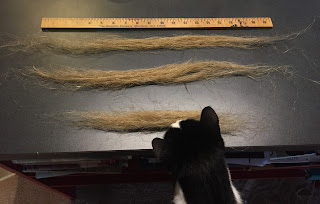John Wily, the author of the 1765 Treatise on the Propagation of Sheep, the Manufacture of Wool, and the Cultivation and Manufacture of Flax, describes in detail how to make a heckle, the wooden-based, iron-toothed comb that you use to strip flax of remaining "hards," or pieces of non-fibrous core of the stalks. For the most refined flax production, Wily says, get yourself a graduate set of heckles, because you can work down to smaller teeth and thus finer flax fibers. "But," he concludes, "many People have only one, of a middle Size," (43).
Living as I do in 2016, and I have a much easier recourse to the internet than to a blacksmith capable of making the the 176 tapered, 4-inch long, steel teeth that Wily says you need to make a heckle. So I bought an antique one. It dates to the nineteenth century, and it's clearly seen some use.
Wily says to take a bunch of your flax, shake it to loosen it, wrap it around a couple fingers, and "fling the other Ends of the Flax on the Points of the Heckle Teeth." Do this enough times, and what you end up with is "the longest of the Flax," which "will make very good Thread," (45).
The problem, I discovered, was that if your initial twist of flax is too big (mine were), you end up hopelessly fouling both the twist and the heckle. Moreover, I suspect that my previous scutching/swingling had left many more hards than Wily would have liked, which also contributed to the mess.
Most importantly, I discovered, you need to keep your twist of flax well in hand, because as soon as I set it down and began to try to pick through it, the neat bunch of fibers transformed itself into a bird's nest.
 |
| I was rather crestfallen at the results. Bertie the cat was rather crestfallen to be trapped indoors. |
What I ended up with was one small twist of pretty decent flax. As you can see from the picture below, as I heckled the flax, the lengths of my fibers decreased because I was breaking more and more of them as I worked them through the heckle's teeth.
 |
| Bertie inspects the flax. |
I also salvaged a wad of "tow," the shorter, bird's nest fibers. Over a couple nights, I managed to pick most of the hards out of the tow wad so that I ended up with a softball-sized, puffy ball of tow.
 |
| Tow before I removed the hards (visible here as lighter-colored splinters). |
In theory, spinning makes sense. You just twist the fibers together like a very tiny rope, and this tension holds them together. But in practice, spinning flax on a wheel is like playing a drumset (I've never played a drum set, but I can barely rub my stomach and pat my head at the same time, so you get where this is going). You power the wheel with foot peddles, the wheel spins and engages with various mechanisms, and you manipulate the raw flax with your hands so that it is gradually spun and sucked up onto a revolving spool. Even with Heather's patient tutelage, I found the my hands and feet were often out of sync. I ended up spinning too fast, creating something that looked far more like twine than thread, or breaking the yarn.
Our result is clearly much heavier than the yarns that early Americans would have wanted for weaving fine linen textiles, but it's still within the realm of possibility for use in things like upholstery webbing.
All told, we ended up with 236 inches (19.66 feet) of tow-based thread and 388 inches (32.33 feet) of finer linen thread. A better heckler could almost certainly have salvaged more fiber from my bird's nests, and a practiced flax spinner could have spun far finer threads and thus produced much more.
But for what it's worth, my 52 feet of yarn is the product of my eight square feet of mediocre soil, planted at the seed ratio Wily recommended in 1765 (which, when reduced down from acres, means two teaspoons of seed per eight square feet). If we assume that average for a whole acre of flax planted in 1765, based on the math I did when I planted back in 2014, we get a result of 278830.5 feet of linen yarn, or a remarkable 52.8 miles! And that's certainly on the far low end of what you could produce with an acre of flax.
So just how much finished textile can 52 feet of coarse linen thread produce? To find out, I need to boil my thread and weave it. Why boiling, you ask? Stay tuned to find out.









No comments:
Post a Comment